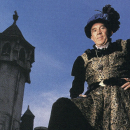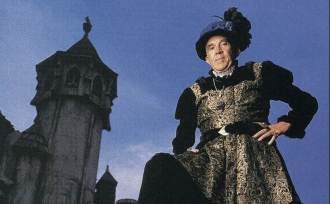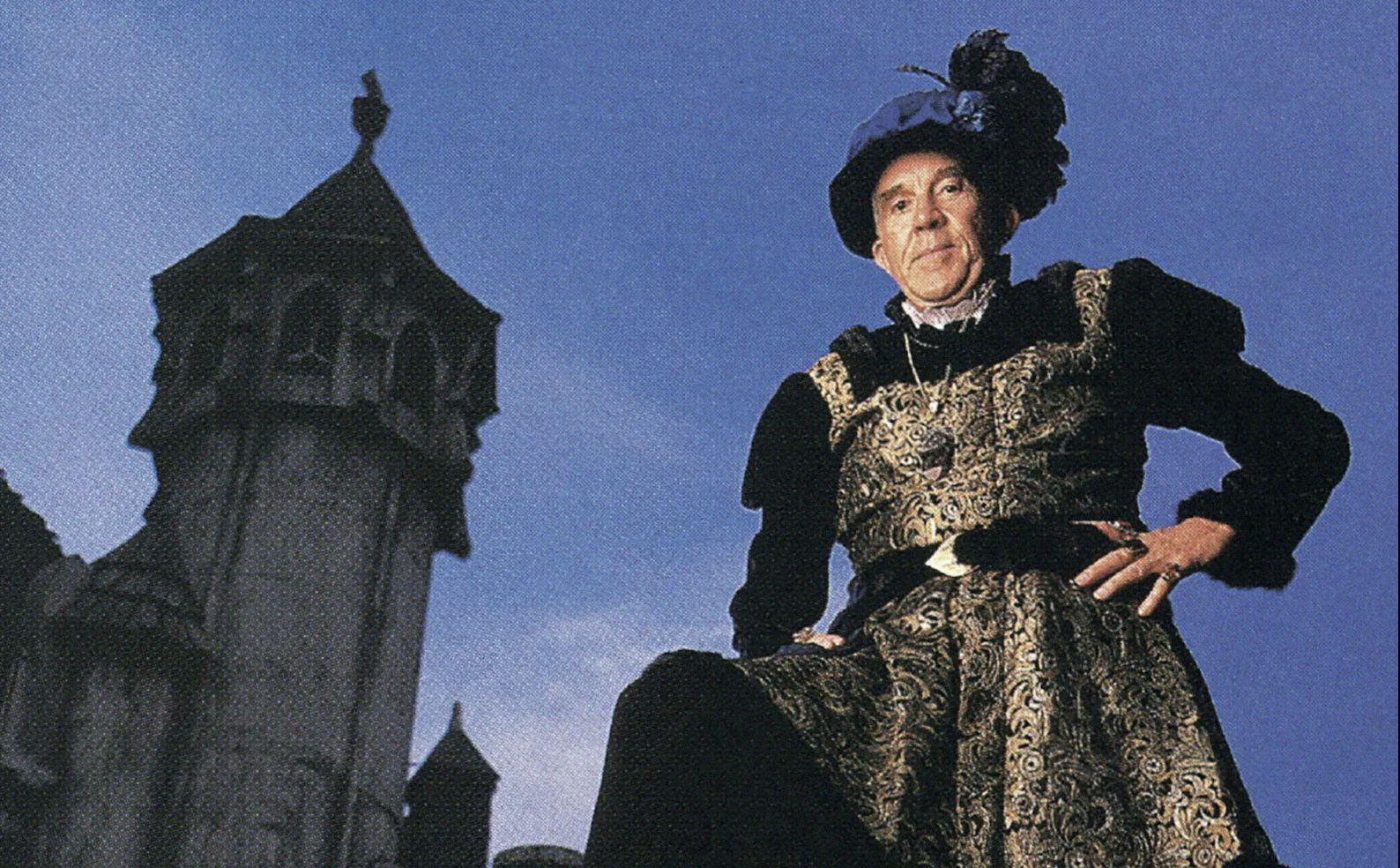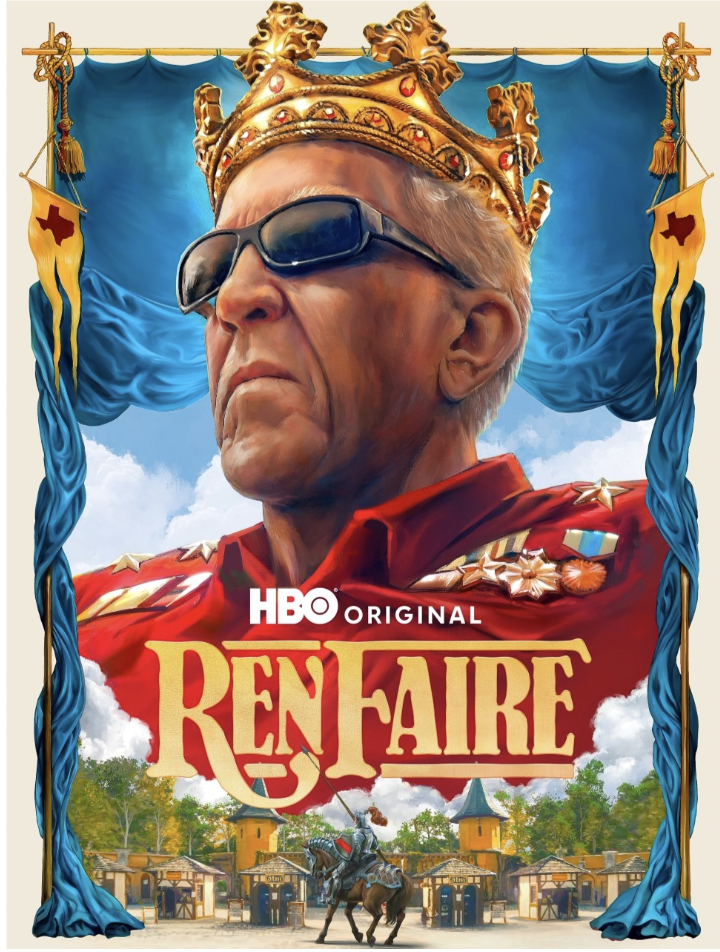As we drive down the deserted streets of New Market Village, it is as though the present has melted away in the late-June heat. The medieval-style buildings with their half-timbered walls and heavy wooden signs pass by like a movie set or images in a dream. I have little trouble catapulting my imagination back five centuries, until (zounds!) my eyes land on Ye Olde ATM, a reminder that we are in neither a movie nor a dream but a theme park, a massive recreational village designed to transport visitors back to olden times.
A fifty-acre medieval village is a strange sight in the middle of Texas. Located in a slice of the Piney Woods between Plantersville and Magnolia, about 45 miles northwest of Houston, the hamlet belongs to a tall, lanky man named George Coulam. So do the nearby orchards and the closest town, Todd Mission, of which the 62-year-old Coulam is the founder and mayor. Coulam—or King George, as his full-time staff of thirteen respectfully refer to him—is also the founder, owner, and head honcho of the Texas Renaissance Festival, one of the largest festivals of its kind in the country.
A seven-week extravaganza that takes place on Saturdays and Sundays through November 14, the festival turns 25 this year. Though its name would seem to indicate that it celebrates the period in Europe extending roughly from the fourteenth century to the seventeenth, the festival plays fast and loose with history, incorporating just about anything with an old-world patina.
Renaissance festivals are known for being havens where nerdy escapists—unregenerate anglophiles, people who wear capes and cloaks and quote endlessly from Monty Python and the Holy Grail in strident English accents or who played too much Dungeons and Dragons as kids (and haven’t stopped)—munch on turkey legs and guzzle wassail while browsing acres of silver jewelry and watching swordfights between guys in tights. And though the festival is a magnet for those types, you’ll also find plenty of people in street clothes strolling around and taking in the spectacle. The festival has been known to attract as many as 37,000 people a day—ordinary tourists as well as peasants, wenches, knights, and various other figures from the past eight centuries or so—who pay an admission fee of $17.95 at the gate.
A man of few words, Coulam is content to let his creations speak for him. As a rule, they are monuments to his idiosyncratic tastes. His pick-your-own orchard, down the road from the festival grounds, produces figs, peaches, blueberries, and strawberries as well as several fruits (like apples) that the experts told him wouldn’t grow in this part of Texas. It is as flawlessly laid out as the gardens at Versailles and equipped with state-of-the-art fertilization equipment. Across the street, his vast estate, Stargate Manor, includes a sprawling sculpture garden, and a forty-acre lake complete with a waterfall and a jogging track is planned; both the lake and the garden will ultimately be open to the public—“when I die,” says Coulam. His house, which he designed in the bizarre, dripping style of the Spanish Modernist Antonio Gaudí, boasts stained-glass windows that he made himself. The floors, furniture, and even dining table are covered with spotted cowhides. A separate, circular art studio he built—where he makes everything from wood sculptures to wrought-iron gates for his estate—features brass-plated doors and porthole windows. His 28-year-old wife, Susie, who is from Thailand, often works side by side with him on her own art projects.
And then there’s the festival itself. Almost every year since its humble beginnings in 1974, when today’s crowded village was little more than the gravel pit Coulam bought that year, he has added a new attraction. The past few years have seen a series of elaborate gardens: a rose garden, a water garden, and this year, formal English gardens. Next year’s addition is going to be a $300,000 Greek amphitheater.
The objects and landscapes Coulam has crafted appear to be his major engagement with the world. As we rumble around his kingdom in his mammoth four-door pickup, he seems rather remote, entirely preoccupied with the environment he has created. He deflects questions about himself, instead pointing out projects he is especially proud of, such as the water gardens and the tree-lined parking lot.
But Coulam is more than an eccentric artist. He is a serious businessman, and he’s also a monomaniacal tyrant who will let nothing stand in the way of his idea of perfection. He has the reputation of being as quick to hire someone with no experience because of an intuition as to fire someone with a stellar résumé who doesn’t fit in. And despite his consuming interest in flowers and art, his language is unapologetically in the gutter. “People whine that he can be rough,” says chef Charles Prince, who is the largest food vendor at the festival, providing everything from alligator-on-a-stick to six-course meals served in the Feast Hall. “He’s got a reputation for being harsh. He’s driven by an obsession for quality, and anything he sees that’s not quality, you’ll get the message. But I think that his keeping the pressure up is what makes it good and makes it work.”
Not surprisingly, Coulam identifies with another purveyor of fantasy. “Everything I got I copied from Walt Disney. I got it right from that book,” he says, referring to The Story of Walt Disney: Maker of Magical Worlds, by Bernice Selden. One of the biggest mistakes Disney made, Coulam thinks, was not foreseeing the suburban growth that would one day hem in Disneyland. Coulam has guarded against that eventuality by buying up as much of the land surrounding the festival grounds as possible and even taking the step of establishing the town of Todd Mission (taking the name from a mission that once existed in the area), where many festival employees live year-round—all in all, some 1,200 acres.
King George was born in Salt Lake City, the third of six children in a Mormon family. “I was a bad dog,” he says of his teenage self. “Up through high school I had no direction. I was a sump head who got into a lot of trouble.” He escaped to San Fernando Valley State College, in Southern California, where as a failed English major he found himself taking art and art history classes. He delved deeply into the studio arts—stained glass, woodworking—and eventually earned his undergraduate and master’s degrees in art. The subject of his thesis was nineteenth-century French architect Eugène-Emmanuel Viollet-le-Duc, who had a penchant for Gothic design.
At about this time, Coulam began attending the first renaissance festivals in California, working in costume hawking the works of a stained-glass artist with whom he apprenticed. Smitten with the idea of the festival, Coulam moved back to Utah and tried to start one of his own there. But he made the Mormon church authorities “very nervous,” he says, and they eventually hinted that his festival might be better appreciated elsewhere. “At that time, the church liked to know everything that was going on around there, and we were a bunch of people waving swords, quoting Shakespeare, and carrying on,” Coulam says. “They’d never seen anything like it.” In 1969 he moved the operation to Minnesota, where it grew steadily over the next five years, but squabbles with the owners of the land he was leasing and other bureaucratic hassles ultimately led him to sell the festival for $350,000. On a nationwide search for a new location, Coulam happened on the property near Houston, fell in love with it, and the rest is ancient history.
Renaissance festivals are popular tourist attractions—almost every state has one—that support a subculture of people known as “rennies.” Says vendor Royce Kerbow, “Any participant in a renaissance festival who attends in costume on a regular basis could be called a rennie.” Rennies can range from traveling actors or performers who get paid to play the festivals to vendors like Kerbow, who owns a permanent medieval-weapons shop at the festival, to paying visitors who just love to dress up.
Kerbow, who is based in Denver, sells original and reproduction historical weapons. When you meet him at the festival, you’ll also meet Lord Roy-ke Khan of the Crimson Horde of the Peace Loving Peoples of the Mongol Empire, an alter ego Kerbow invented for himself in the mid-seventies. “We put down a revolt by the king of Korea the same year we conquered Hungary and Poland, 1241,” he tells me in his Southern accent. “We burned Baghdad and Hanoi to the ground within a year of each other.”
Beyond all the jolly good fun, the festival is big business. Kerbow, who spends $825 a year to maintain a shop that is open for only fourteen days, has grossed as much as $40,000 in one year selling his swords, daggers, and spears at the festival. “I never have to take a vacation anywhere because I spend half of my life in one century and half in another,” he told me.
Honey and Paul Groos run an elaborate import business whose only showcase is the festival. Every year, the couple spends a month or two in Asia, collecting rare and valuable items from Thailand, Hong Kong, Bali, and China. They show me elegant bone carvings, handmade furniture, and even an intricately carved, thirteen-foot jade boat that will carry a price tag of $23,500. Of course, most of us wouldn’t dream of spending twenty grand at a theme park, but the Grooses have an exclusive clientele for their most unusual items. “For the first weekend, we do a mailout,” Paul Groos says. “Invitation only. We give them two tickets to the festival, and they come here and are served tea as they peruse our inventory.” In a good year, he says, he and his wife gross $500,000 to $600,000.
“All we provide is the place,” says Coulam laconically. “I don’t run anything. All the foods, drinks, rides, games, fortune-tellers, face-painters, artists, craftsmen, jugglers, mimes, and musical groups are independent.” True enough, but they must follow Coulam’s strict aesthetic guidelines, which are laid out in the Participants Handbook. Every vendor is responsible for building his or her own “shoppe,” but its design must be approved by the festival management, which requires variations on the Tudor-era half-timbered style. Costume is a serious matter: “Every participant must have an approved period costume including a hat and appropriate footwear. . . . No watches, sunglasses, radios, telephones, or any other modern conveniences are permitted in view of the customer at any time.” Staff members tell the story of a festival worker who was spied by King George smoking a cigarette behind one of the shops. He did not return to work the next day.
And you won’t hear vendors telling customers “Y’all come back” in a Texas twang. They are required to speak what the handbook calls the King’s English. “Can I help you?” becomes “What be thy pleasure, m’lord?” while “The bathrooms are over there” is translated as “Privies be over yonder.” Forsooth, a slate of useful insults is even provided: “Out of my sight, wretch. Thou dost infect mine eyes.”
Entertainment coordinator Jeffrey Baldwin oversees the more than five hundred actors the festival employs to be part of the scenery, who must attend seven weekends of rehearsal. They range in age from 7 to 72 and include families hired to portray peasants and two actors who play King Henry VIII and his fourth wife, Anne of Cleves. Since the festival’s second year, the daredevils who perform the jousting have been local ranchers; after seeing the lily-livered job done by the Hollywood stuntmen who were initially hired, they went to Coulam and said they could do better. “And they do,” says King George. “Those are some crazy guys. I guarantee every year some bones get broken. And they may have some trouble keeping up the King’s English, but they put on a damn good show.”
Attendance at the festival has boomed since the mid-nineties. While the early part of the decade saw attendance averaging 210,000 for the duration of the event, that figure has skyrocketed to around 290,000 in the past four years. Everyone you talk to attributes this success to George Coulam. “Everything he does centers around the festival,” says Frank Dean, a local businessman who has known Coulam for twenty years. “It’s his life.”
Says Baldwin: “I like to think of him as Willy Wonka from Charlie and the Chocolate Factory. He’s given a few of us lucky ones those golden tickets to come here and live.”
Coulam has designed a personal coat of arms that can be found embroidered like a monogram on his shirts and on the satin bedspread he made himself for his queen-size bed. In its four quadrants the coat of arms depicts a tree, representing his interest in horticulture; a paintbrush, for his artistic side; a boat, to show his love of travel; and a phallus, to indicate his sensuality. As King George might put it, what more is there to say?
By Jordan Mackay, November 1999



 Lizzie Kunde
Lizzie Kunde 



